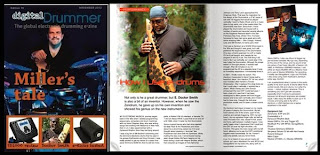I was honored when Allan Leibowitz, editor of digitalDrummer magazine asked to do a feature on me for the November 2013 issue. Here's the text of the article below!
"Not only is he a great drummer, but E. Doctor Smith is also a bit of an
inventor. However, when he saw the Zendrum, he gave up on his own
invention and showed his genius on the new instrument." -Allan
Leibowitz, Editor digitalDrummer.
My electronic musical journey
began back in the ‘80s when I started programming sequencers, computers,
and drum machines with my friend Stephen Bray, who was writing songs
and working with Madonna in New York, then in LA. I also experimented
with a Dynacord Rhythm Stick they had lying around. I was a big fan of
Bill Bruford’s drumming and the Simmons electronic drums that he used in
his groups Earthworks and King Crimson. I was really excited to get my
hands on a basic 5-piece Simmons SDS9 kit, then to add 6 more pads, a
Roland PM-16 interface, a Yamaha TX-7, and an Alesis HR16. I used that
kit on and off until 1995, when I made my first Drummstick.
Some
musical friends, who had once opened for Bela Fleck & the Flecktones
and knew about my e-drumming, asked me if I’d ever thought about
creating a “drumitar” like Futureman had done with his Synthaxe. While
mulling the idea over, I remembered having seen singer Bobby McFerrin
tapping on his torso during a duet with Wayne Shorter, which had
conjured up images of how Alphonso Johnson and Tony Levin approached the
Chapman Stick. That was the inspiration for the design of the
Drummstick, a 2” x 6’ piece of oak with 16 triggers that would be played
vertically. I went to Radio Shack and a to music store to buy parts,
and a few weeks later, the Drummstick was born. Since then, I have
played the Dummstick and toured with a number of bands and recorded
several albums on the Edgetone Records label in the SF Bay Area where I
live. I’ve been honored to have had some great jams with some amazing
folks—Bon Lozago, Howard Levy, and Bill Kirchen, to name just a few!
I
first saw a Zendrum at a NAMM show back in the ‘90s and thought it was
great, but I still preferred the ergonomics of the Drummstick. One day, a
friend surprised me with a maple ZX he’d just bought, and happily let
me program it and try it out. The first thing I did was to flip it up
vertically, so I could play it the way I play the Drummstick. Although
the straps weren't in the right places, it worked well enough. After 20
minutes or so, I'd programmed the ZX to a playable level. It was so
incredibly responsive. I immediately loved it.
In 2007, I
finally made the switch. The Zendrum Corporation’s David Haney built a
beautiful, black “Jimi Hendrix ZX” for me, which was modeled after
Hendrix’s Fender Stratocaster. After I replaced the strap locks, so that
I could play it vertically, it worked like a charm. When Haney and John
Emrich announced the new Zendrum, “EXP”, in late spring, I took a look
at it, saw that it had been redesigned to allow greater left hand
trigger access and to be worn vertically, and I knew I had to have one. I
bought the first ever production model, and it’s been a dream come
true.
Live, I’m a hybrid of new school meets old school, so I
use a MacBook Pro with BFD2 and GarageBand for my basic kits, along with
an Alesis DMPro. I also use iDrum to trigger my pre-recorded samples.
My rigs vary depending on the size of the venue, and my sound is fed
into either a Fast Track Ultra 8R, a Tascam US-1800, or PreSonus
USB/MIDI interface. I use either an Alesis iMultiMix 9R or a Mackie
mixer and a pair of Mackie SRM450s. For recording, I mostly use
GarageBand, Logic, and ProTools. I also enjoy using Darin Kadrioski’s
Zendrum editor app, ZenEdit.
My Zendrum technique is based on my
nearly 20 years of playing the Drummstick. My left hand carries a lot of
the snare, open hi-hat, crashes, and sample triggering. With my right
hand, I do my signature finger rolls, as well as carry the basic kick,
ride, closed hi-hat, snare, and toms, split between multiple fingers. I
was really happy when I discovered that I could put the EXP on over my
right shoulder, ala Hendrix. This gave me more range with my left hand,
allowing me to use the EXP’s additional triggers more comfortably. So
far, I haven’t used any pedals, but you never know.
I am a
perfectionist when it comes to the audio quality of my drum sound.
E-drums allow me to control reverb, EQ, and volume, no matter the
venue—indoor, outdoor, wherever. This is something you don’t get with
acoustics, especially when it comes to percussion, because not all sound
engineers are created equal. I also enjoy the ability to pack up in 15
minutes and being able to fly with a Zendrum, a USB interface, and a
laptop anywhere in the world!
Equipment list:
Zendrum EXP
Zendrum ZX
Drummstick x 3
Dynacord Rhythm Stick
Fast Track Ultra USB MIDI Interface
Tascam US-1800 USB MiDI Interface
PreSonus Audio Box USB MiDI Interface
Alesis DMPro, D4 and Trigger I/O
MacBook Pro with BFD2, GarageBand, iDrum
10 piece Simmons SDS9 kit
6 piece Ddrum D2 kit with Hart Dynamics mesh heads
Roland Octopad
Meinl Cajon
Mackie CR1604, 2 x Mackie SRM450

No comments:
Post a Comment